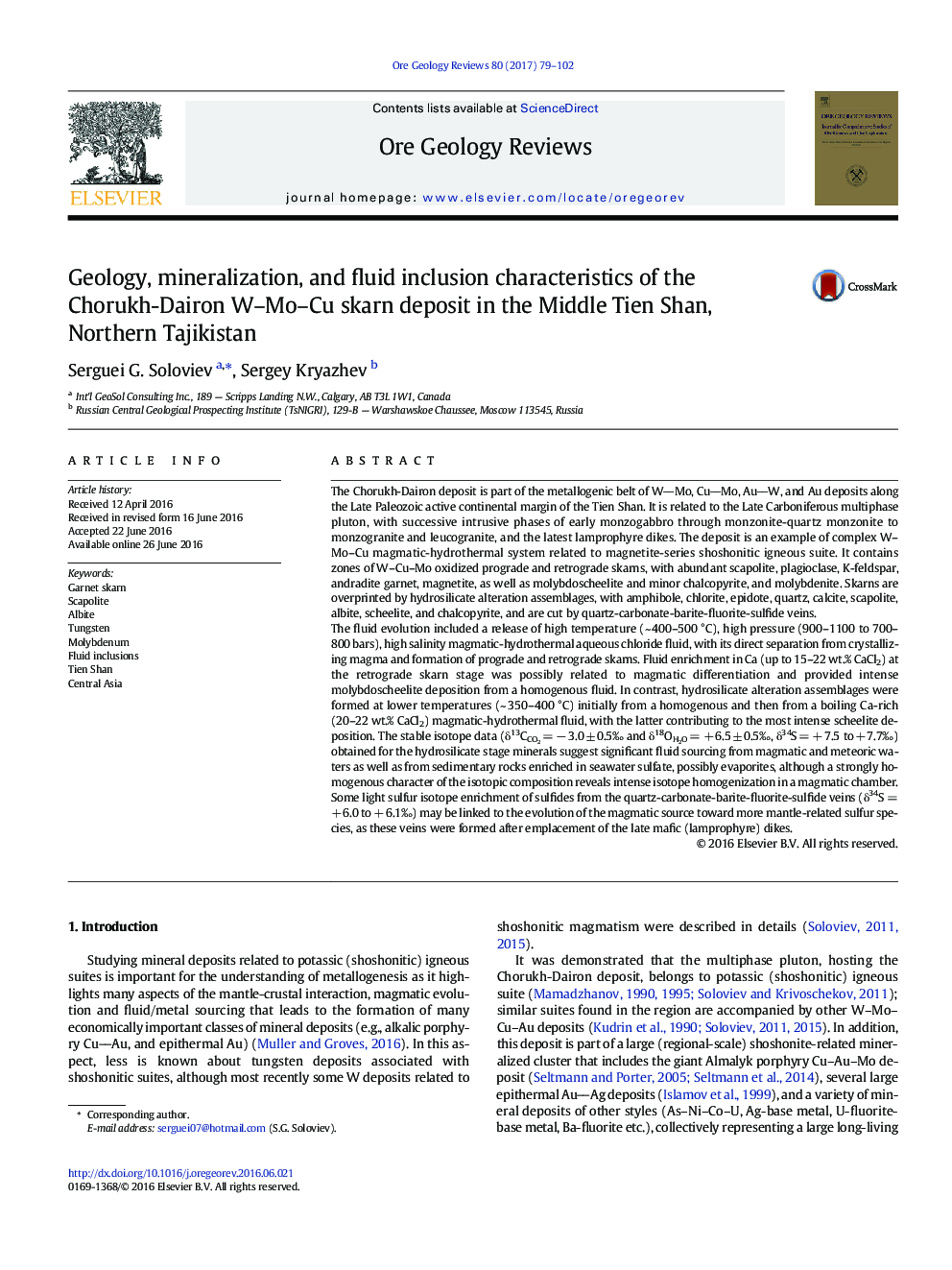| کد مقاله | کد نشریه | سال انتشار | مقاله انگلیسی | نسخه تمام متن |
|---|---|---|---|---|
| 6435587 | 1637226 | 2017 | 24 صفحه PDF | دانلود رایگان |

- The deposit is an example of the oxidized-type skarn related to high-K to shoshonitic igneous suite.
- Two to three major stages of scheelite and sulfide deposition occurred.
- Fluid evolution included an early high-temperature, high-pressure, and high-salinity homogenous fluid.
- At a later stage, fluid boiling contributed to intense scheelite deposition.
- Fluids have been sourced from crystallizing magma, with progressing admixture of meteoric water.
The Chorukh-Dairon deposit is part of the metallogenic belt of WMo, CuMo, AuW, and Au deposits along the Late Paleozoic active continental margin of the Tien Shan. It is related to the Late Carboniferous multiphase pluton, with successive intrusive phases of early monzogabbro through monzonite-quartz monzonite to monzogranite and leucogranite, and the latest lamprophyre dikes. The deposit is an example of complex W-Mo-Cu magmatic-hydrothermal system related to magnetite-series shoshonitic igneous suite. It contains zones of W-Cu-Mo oxidized prograde and retrograde skarns, with abundant scapolite, plagioclase, K-feldspar, andradite garnet, magnetite, as well as molybdoscheelite and minor chalcopyrite, and molybdenite. Skarns are overprinted by hydrosilicate alteration assemblages, with amphibole, chlorite, epidote, quartz, calcite, scapolite, albite, scheelite, and chalcopyrite, and are cut by quartz-carbonate-barite-fluorite-sulfide veins.The fluid evolution included a release of high temperature (~ 400-500 °C), high pressure (900-1100 to 700-800 bars), high salinity magmatic-hydrothermal aqueous chloride fluid, with its direct separation from crystallizing magma and formation of prograde and retrograde skarns. Fluid enrichment in Ca (up to 15-22 wt.% CaCl2) at the retrograde skarn stage was possibly related to magmatic differentiation and provided intense molybdoscheelite deposition from a homogenous fluid. In contrast, hydrosilicate alteration assemblages were formed at lower temperatures (~ 350-400 °C) initially from a homogenous and then from a boiling Ca-rich (20-22 wt.% CaCl2) magmatic-hydrothermal fluid, with the latter contributing to the most intense scheelite deposition. The stable isotope data (δ13CCO2 = â 3.0 ± 0.5â° and δ18ÐH2O = + 6.5 ± 0.5â°, δ34S = + 7.5 to + 7.7â°) obtained for the hydrosilicate stage minerals suggest significant fluid sourcing from magmatic and meteoric waters as well as from sedimentary rocks enriched in seawater sulfate, possibly evaporites, although a strongly homogenous character of the isotopic composition reveals intense isotope homogenization in a magmatic chamber. Some light sulfur isotope enrichment of sulfides from the quartz-carbonate-barite-fluorite-sulfide veins (δ34S = + 6.0 to + 6.1â°) may be linked to the evolution of the magmatic source toward more mantle-related sulfur species, as these veins were formed after emplacement of the late mafic (lamprophyre) dikes.
Journal: Ore Geology Reviews - Volume 80, January 2017, Pages 79-102